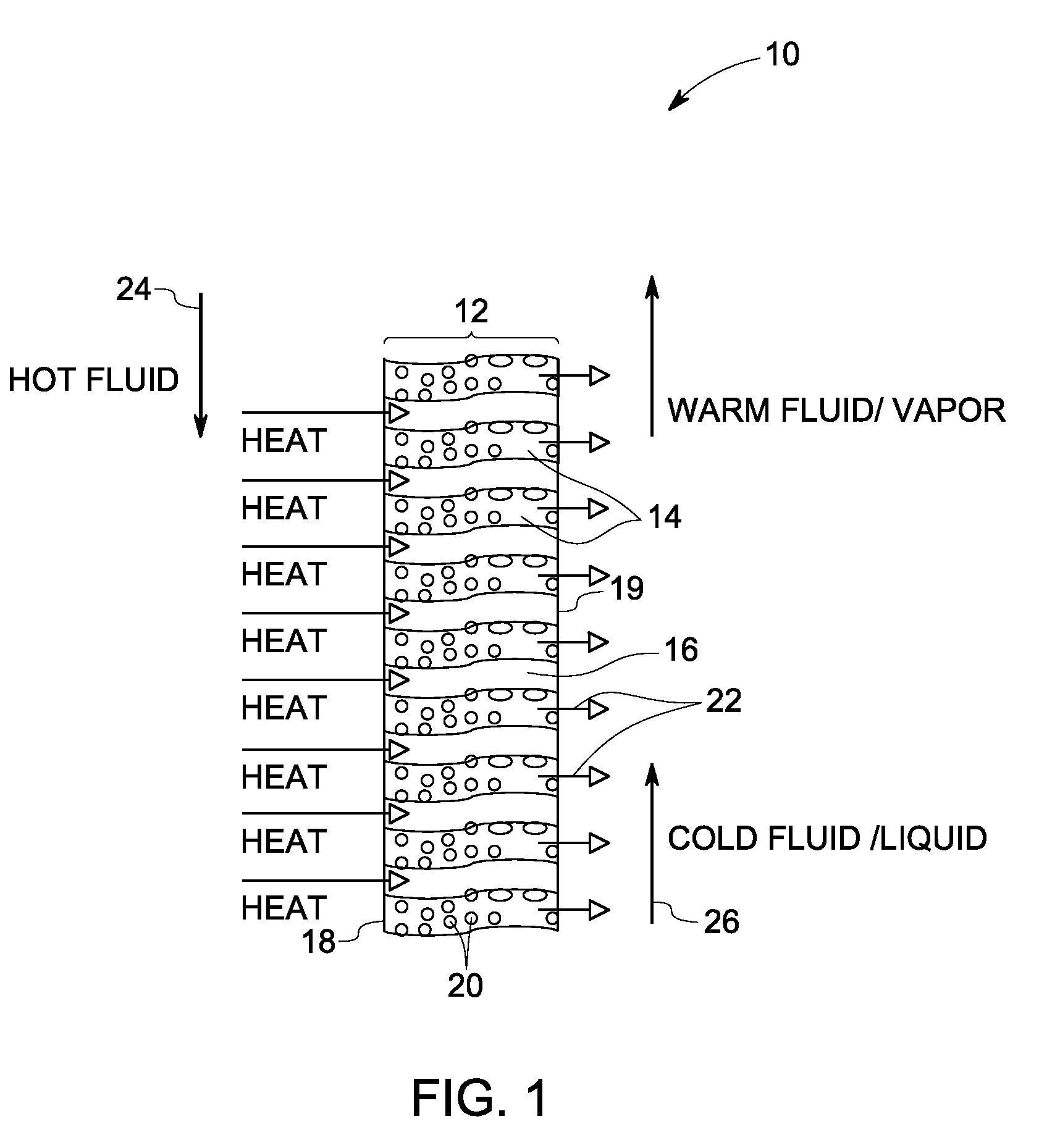Gas Separator Apparatus
a gas separator and membrane technology, applied in the field of membrane based gas separators, can solve the problems of increasing fuel requirements, reducing the overall efficiency of the plant, so as to promote the selective transport of at least one species, facilitate heat transport, and promote the effect of selective co2 transpor
- Summary
- Abstract
- Description
- Claims
- Application Information
AI Technical Summary
Benefits of technology
Problems solved by technology
Method used
Image
Examples
example 1
Templated mesoporous silica Disposed within a Porous Stainless Steel Membrane Support
[0057]A porous stainless steel substrate with an average pore size of 0.2 micrometers was provided. The stainless steel support was pre-oxidized in air at 600° C. for 2 hours prior to infiltration by the precursor. The oxidative pre-treatment produces a thin oxide layer on the metal surface that promotes adhesion of silica to the porous metal support. The mesoporous silica deposition was performed by liquid phase infiltration of the silica precursor into the support, followed by heat treatment to convert the precursor into an oxide. Multiple infiltration cycles were used to improve the extent of filling. The precursor solution was prepared by mixing an organic templating agent and a silica precursor in an acidic mixture of ethanol and water. In this example, two representative templates (Brij 56 and Pluronic F127 (products from BASF chemical company)) were used as the templating agent, tetraethylort...
example 2
Polynorbornene in Porous Stainless Steel Membrane Support
[0060]The polynorbornene was disposed in the porous support. Multiple infiltration steps were used to ensure a hermetic deposit.
[0061]The benefit of the invention in thermal conductivity was seen by comparing the thermal conductivity of a membrane structure comprising polynorbornene in a porous nickel alloy support, to a free-standing polymer membrane. Since the porous metal support provides the mechanical strength of the membrane structure, the polynorbornene need only hermetically fill part of the porosity of the support. Since there are parallel paths for heat transfer and the thermal conductivity of polynorbornene is at least 2 orders of magnitude less than nickel alloys (k˜40-70 W / m / K), the thermal conductivity of the membrane structure was the thermal conductivity of the support, kNi, scaled by the solid fraction, 1-εss, of the support. This approximation applies for pre-oxidized metal supports, provided the thickness of...
example 3
Polymerized ionic liquid (poly(vinyl benzyltrimethylammonium tetrafluoroborate), p[VBTMA][BF4]) in Porous Stainless Steel Membrane Support
[0063]In this example, a membrane comprising polymerized ionic liquids was disposed within the pores of a porous metal support is described. The deposition was performed by infiltration of a monomer solution into the porous support, followed by in situ polymerization. Optionally, the metal membrane was pre-oxidized and treated with a silane linker molecule to enable covalent linkage of the polymerized ionic liquid to the porous metal support.
[0064]The membrane in this example was prepared adding 2 g of p-vinylbenzyltrimethylammonium tetrafluoroborate monomer, 20 mg 2,2′-azobisisobutyronitrile (AIBN), 4 mL N,N-dimethylformamide (DMF) and 3-(trimethylsilyl)propyl methacrylate-treated porous stainless steel membrane to a reaction tube. The tube was sealed, degased under nitrogen, and immersed in an oil bath at 60° C. for 6 h. The membrane was subsequ...
PUM
| Property | Measurement | Unit |
|---|---|---|
| thermal conductivity | aaaaa | aaaaa |
| porosity volume fraction | aaaaa | aaaaa |
| porosity volume fraction | aaaaa | aaaaa |
Abstract
Description
Claims
Application Information
 Login to View More
Login to View More - R&D
- Intellectual Property
- Life Sciences
- Materials
- Tech Scout
- Unparalleled Data Quality
- Higher Quality Content
- 60% Fewer Hallucinations
Browse by: Latest US Patents, China's latest patents, Technical Efficacy Thesaurus, Application Domain, Technology Topic, Popular Technical Reports.
© 2025 PatSnap. All rights reserved.Legal|Privacy policy|Modern Slavery Act Transparency Statement|Sitemap|About US| Contact US: help@patsnap.com



